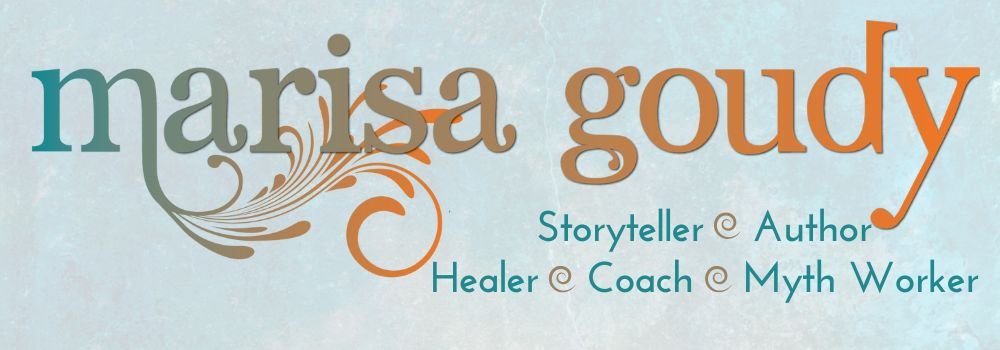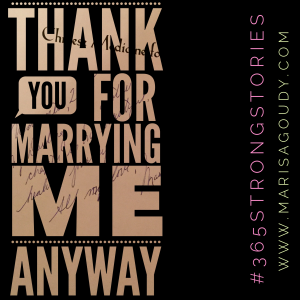What do you mean you can't read my mind? Advice for lovers and writers #365StrongStories by Marisa Goudy
The fighting is over, but it’s not quite time for kiss and make up. It’s that tender, in-between time when neither is ready to dissolve into love but both are grateful that the crisis has passed. If you’re watching the sort of movie that allows the characters to take a breath between the plate throwing and the shot of the heap of clothes on the floor, there might be a song to move the action away from conflict and toward romance.
Any director worth her salt would say “we need a song that feels like ‘Let’s Stay Together.’ But obviously we need to pick to something less… obvious.”
Thing is, sometimes real life is just that cheesy and obvious.
What do you mean you don't know that song?
This weekend saw a disagreement in the Goudy kitchen. No plates were thrown, but someone may have been asked to quit putting the dishes away and make some g.d. eye contact so we could talk things through.
And just in that movie-perfect moment when we’d found our way back to common ground and the kids were playing quietly in the other room, "Let's Stay Together" came on the radio.
And then my husband opened the fridge to make a sandwich. He seemed to understand my hopeful, love song-inspired smile to mean “would you make me one too?”
After a moment or two, my soft look turns into the prelude to a snarl. “Um,” I say, “This is the part when you sweep me into your arms and we fall in love with the universe and with each other just a little bit more because this song played at this moment.”
“What song?”
I have married the only man in America who does not know “Let’s Stay Together.” Ok. I can breathe through this.
“How can you not…?” Right. I’m breathing. We’re in making up mode. I’m freaking breathing. “Ok, then how about you listen to the words?”
“You know I never listen to words.” Yep. I, the writer, am married to man who never listens to the lyrics.
This is actually relationship magic at work
In the end, this didn't cook up a new battle. It was a chance to remember that as much music as we’ve shared in the last twelve years, we’ve managed to stay together without Al Green’s help. It was a chance to see that we don’t always share a common language of songs, symbols, and words even though we’ve pledge to share our lives together.
As a partner in a marriage, this is an essential realization, and I know it will change how we communicate. I’ll leave the deeper discussion to the beloved and brilliant relationship therapists and coaches in my client circle like Lily Zehner and Robyn d’Angelo.
I know they can help us understand what’s really going on here and how to recognize and shape such moments into opportunities for connection.
This is actually storytelling and sharing magic at work
I'm analyzing this moment through my writer’s spectacles.
Even when you’re speaking a common tongue to a carefully chosen ideal client, you don’t necessarily share a complete set of reference points.
You, dear reader, may not think that every person in America would know “Let’s Stay Together.” You may not be drawn into the story of a married couple’s spat because you haven’t met “the one” yet or because monogamy just isn’t for you.
A while back, someone left a reason for unsubscribing from my newsletter: “I don’t identify with the voice in these messages.” When I first read that it seemed a little bit like “I don’t like you as a person,” but now I can see that we just didn’t share enough common reference points to make the connection.
Three ways to stay connected to your readers
So what do you do, especially when you’re communicating in writing and you can’t clear up a misunderstanding with a smooch? How do you make sure you're working with a shared frame of reference?
1) Check with your assumptions that “everyone knows about this!”
You may be using your favorite TV show to help you illustrate your point, but if it’s a niche program with only a few million viewers, you can’t assume that everyone is in on the secret. (But really, you all would love Outlander and I wish we could all watch it together every Saturday as long as you promise not to talk during the episode!)
2) Seek feedback from people you trust
If you have a story to tell or want to build a blog post around a specific example check in with a trusted circle of early readers. Ask them if they get the references (“What do you mean you didn’t watch Inspector Gadget before school in the 80s?"). Revise or add context as necessary.
3) Value clarity over cleverness
Ingrid Bergman was so right with “Be yourself. The world worships an original.” When the world isn't worshipping the latest cookie cutter pop singer, it’s totally true.
Dare to give us your unique voice and perspective - please! Just remember that you’re blogging to build a practice or a business. If you alienate your readers by telling stories and using examples they can't relate to, you need to reevaluate your goals or your approach.
Another way to stay connected with your readers is to understand the Story Triangle. Take the free class that teaches you how to use storytelling to inspire and engage your ideal clients.



